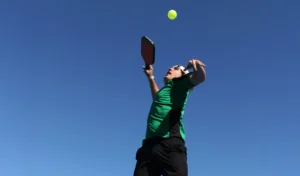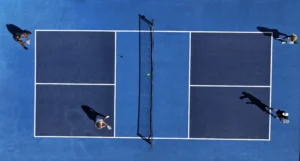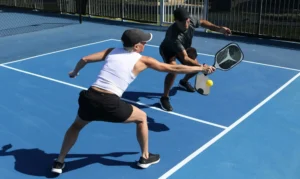
A pickleball serve is not just a matter of getting the ball in play—it’s a strategic asset that can influence the entire rally in the game. As a beginner, you should master this because a solid and consistent serve can get you ahead of the game and have your opponents playing catch-up. Understanding the rules, types of serves, and key strategies will help you control the game and keep the pressure on your opponents.
In this guide, we’ll break down everything you need to know about serving in pickleball, including the official rules, different serve styles, and expert tips to improve your accuracy and power.
Pickleball Serve Rules: The Basics You Need to Know
Before getting to the technique, knowing the basic serve rules is good. Adhering to these rules, you will have a balanced game and prevent unwanted faults. Let’s begin with the basics!Let us begin acquainting ourselves with the rules of serve in pickleball. Following these rules, you will have an even game and prevent faults.
1. Underhand Serve Rule
All underhands are—your paddle has to strike the ball below your waist in a rising manner. Sidearm or overhand serves are not allowed.
2. Foot placement
- At least one foot should remain behind the baseline during serving.
- Your feet should not reach the baseline or the court before hitting the ball.
- You can’t step over the service extension of the imaginary sideline.
3. Diagonal Service
Throw the ball diagonally across to the opponent’s service court (right to the right or left to the left). Clear the non-volley zone (kitchen) and land within the service box.
4. One Serve Attempt
In contrast to tennis, pickleball allows only one attempt at a serve per point. A let serve that touches the net but falls within the correct service court may be retried.
5. Doubles Serving Order
- The serving team starts with one player serving and then passing it to the other team.
- After the first rally, each player serves before the serve is returned to the other team.
Types of Pickleball Serves
Controlling different types of serves allows you to be in control during rallies, cause uncertainty to others, and be the first to win. Below are some essential serves to include in your arsenal:
1. The Basic Underhand Serve (best for beginners)
This is the most common serve, with an emphasis on accuracy and consistency. It’s great to start with and minimize imperfections.
Technique:
- Keep your paddle at waist level and pull it up.
- Shoot across the opponent’s service court.
- Relax your wrist for a better grip. Best Used For:
Best Used For:
- Beginners learning proper serving mechanics.
- Playing it safe to start a rally.
2. The Deep Serve (For pinning down opponents)
A deep serve puts the ball close to the baseline, causing your opponent to step back and lose their ability to hit a powerful return.
Technique:
- Employ a low-to-high movement to create depth.
- Shoot for the rear third of the court.
- Keep the ball deep without surrendering control.
Best Used For:
- Keep away aggressive players from reaching the net.
- Forcing the opponents into a defensive stance.
3. The Power Serve (For putting pressure on opponents)
A fast and deep serve can catch your opponent off guard, limiting their ability to return aggressively.
Technique:
- Stand slightly behind the baseline for extra momentum.
- Use a quick, controlled swing with a firm wrist.
- Aim deep, ensuring your serve stays in bounds.
Best Used For:
- Gaining a quick advantage in rallies.
- Keeping opponents off balance.
4. The Topspin Serve (For unpredictable bounces)
Adding topspin makes the ball dip quickly after crossing the net, making it harder for opponents to return.
Technique:
- Brush upward on the ball with your paddle face slightly open.
- Generate enough spin to make the ball dip after crossing the net.
- Aim for depth while keeping the ball in play.
Best Used For:
- Throwing off opponents who struggle with spin.
- Forcing weaker returns.
5. The Lob Serve (For disrupting opponents’ rhythm)
This serve sends the ball high and deep, forcing the opponent to adjust their position.
Technique:
- Use a gentle and upward motion to lift the ball.
- Aim high over the net so it lands near the baseline.
- Avoid hitting it too short, setting up an easy smash for your opponent.
Best Used For:
- Slowing down fast-paced games.
- Forcing opponents into awkward positions.
Serving Strategies & Techniques for Better Performance
A good serve is not merely speed—it’s placement, spin, and accuracy. This is how you can master the serve:
1. Aim for the Deep Corners
Keeping your serve deep pushes the other players back, so it is harder for them to take control of the rally.
2. Keep Your Opponent Guessing
Don’t be predictable! Mix up your serves between deep, lob, and topspin to keep your opponent off balance.
3. Stay Relaxed & Balanced
A tense grip or stiff stance can reduce accuracy. Stay relaxed and flexible, using a smooth swing to generate consistency.
4. Work on Your Follow-Through
A full follow-through helps with control and depth. Don’t stop your motion right after hitting the ball—let the paddle complete the swing naturally.
5. Practice, Practice, Practice!
The more you serve, the better your consistency, accuracy, and confidence will become. Set aside dedicated practice time for serving drills.
Common Pickleball Serving Mistakes (And How to Fix Them)
Even experienced players make mistakes! Here’s what to watch for:
- Foot Faults: Keep at least one foot behind the baseline until after contact.
- Too Many Faults from Overhitting: Focus on accuracy before power. A controlled, deep serve is better than an out-of-bounds serve.
- Predictable Serves: Vary your speed, placement, and spin to keep opponents guessing.
FAQs About Serving in Pickleball
Can I serve overhand in pickleball?
No, all serves must be underhand, with the paddle making contact below the waist.
What happens if my serve hits the net?
If it lands in the correct service box after hitting the net, it’s a let and you can redo the serve. If it lands out of bounds, it’s a fault.
How do I make my serve more powerful?
Use your legs, core, and paddle speed to generate power. A fast, controlled swing is key.
Should I serve with spin or depth?
Both! A deep serve keeps opponents back, while a spin serve makes it harder to return. Use different serves strategically.
Can I stand anywhere behind the baseline to serve?
Yes, as long as your feet stay behind the baseline and within the sideline boundaries.
Final Thoughts: Master Your Pickleball Serve
Serving in pickleball is more than just getting the ball over the net—it’s about setting up your game strategically. Whether you’re perfecting a deep serve, adding topspin, or using a lob serve to throw off your opponent, practice and variation are key to becoming a better server.
Want to step up your pickleball game? Start by improving your serve—because every great rally begins with a great shot!


